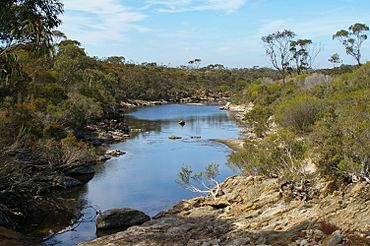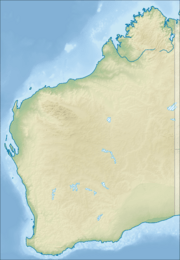Fitzgerald River National Park facts for kids
Quick facts for kids Fitzgerald River National ParkWestern Australia |
|
|---|---|
|
IUCN Category II (National Park)
|
|

Gairdner River in the National Park
|
|
| Established | 1973 |
| Area | 2,972.11 km2 (1,147.5 sq mi) |
| Visitation | 40,000 (in 2008) |
| Managing authorities | Department of Biodiversity, Conservation, and Attractions |
| Website | Fitzgerald River National Park |
| See also | List of protected areas of Western Australia |
Fitzgerald River National Park is a special place in Western Australia. It is about 419 kilometers (260 miles) southeast of Perth. This park is located in two areas called the Shires of Ravensthorpe and Jerramungup.
Contents
About the Park
This huge park covers about 329,882 hectares (over 815,000 acres)! It is home to the Barren Mountains, which include East, Middle, and West Mount Barren. The Eyre Range and the Fitzgerald River also flow through it. The park is part of the Fitzgerald Biosphere. This means it is a very important natural area.
Many unique plants grow here. There are 62 plant species found only in this park. Another 48 species are very rare and not often seen elsewhere.
In 2008, nearly 40,000 people visited the park. The government invested a lot of money to improve it. This money helped to build new roads and walking trails. It also helped to upgrade visitor areas.
Point Ann is a special spot in the park. It is one of only two places on Australia's coast where southern right whales come. They visit in winter to have their babies.
The Quaalup Homestead Wilderness Retreat is inside the park. It was built in 1858 by the Wellstead Family. Today, it is run as a hotel.
You can get to the park from the west side near Bremer Bay. You can also enter from the east side near Hopetoun. The middle part of the park can only be reached with a four-wheel drive vehicle or by walking.
Some mountains in the park are closed to climbers. This is to stop the spread of a plant disease called dieback. It is also known as root rot.
Twertup Area
The northwest part of the park is called Twertup. This name is used for many plants and places in the area. There was once a building called the Twertup Field Studies Centre. It was destroyed by fire.
An old story from the Nyungar people talks about the Twertup area. A friend named Gimbuck told a writer, Ethel Hassell, to be careful there. She said to sleep with two fires and away from water. This was because of many 'wild dogs' or dingos in the area.
Plants and Animals
The park is part of the UNESCO Man and Biosphere Program. This means it is a very important natural area around the world. It has over 1,800 types of plants. About 250 of these are rare. A total of 62 plant types are found only in this park.
Amazing Plants
Some interesting plants you might see include:
- The royal hakea
- The qualup bell
- The scarlet banksia
- The showy banksia
- The bell-fruit mallee
- Different types of pea flowers
- Many feather flowers
- Lots of eucalypts and bottlebrushes (like Callistemon and Beaufortia)
Some plants in the park are very rare. For example, there are only 140 crowned mallee trees in the world. All of them grow here. Also, there are only about 100 Boronia clavata plants left. They are all in this park. Two other endangered plants, the barrens wedding bush and the fan-leaf grevillea, also live here.
Wonderful Animals
The park is home to many animals. It has 22 types of mammals, 200 kinds of birds, 41 types of reptiles, and 12 types of frogs. It is known as an Important Bird Area. This means it is very important for birds.
Some rare birds you might spot are:
- The western bristlebird
- The western ground parrot
- The western whipbird
The endangered malleefowl also lives here. It has been seen seven times since 1998.
Some mammals found here were once thought to be extinct. These include the very rare dibbler and the heath rat. Other animals like the tammar wallaby and woylie are also found here. They are both threatened species. You might also see the quenda, chuditch, and the red-tailed phascogale.
Migratory birds use the wetlands and coastal areas as a safe place. Birds that visit the park include the white-bellied sea eagle, Pacific swift, and the Caspian tern.
Images for kids
See also
 In Spanish: Parque nacional Río Fitzgerald para niños
In Spanish: Parque nacional Río Fitzgerald para niños







